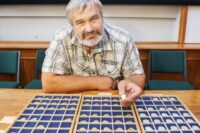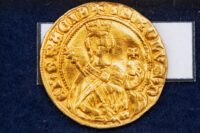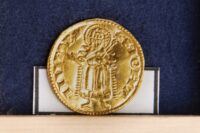 A hoard of 435 gold and silver coins from the 14th century was discovered by a couple on a walk in the woods near Kladruby Monastery in western Bohemia, Czech Republic. Well, technically, the hoard was discovered by a wild pig who started the excavation. The couple came across a two gold coins and one silver in the brush next to a large flat stone. When they lifted the stone, they saw there were many more coins underneath it. They reported the find to the Museum of West Bohemia in Plzeň and archaeologists unearthed the whole hoard.
A hoard of 435 gold and silver coins from the 14th century was discovered by a couple on a walk in the woods near Kladruby Monastery in western Bohemia, Czech Republic. Well, technically, the hoard was discovered by a wild pig who started the excavation. The couple came across a two gold coins and one silver in the brush next to a large flat stone. When they lifted the stone, they saw there were many more coins underneath it. They reported the find to the Museum of West Bohemia in Plzeň and archaeologists unearthed the whole hoard.
 There are 92 gold coins weighing a total of 326 grams and 343 silver coins in the hoard. The silver coins are of the groschen type which were common in Bohemia and central Europe in the 14th century. Most of the ones in the hoard were minted in Bohemia during the reign of Holy Roman Emperor Charles IV. They are very worn so must have been in wide circulation. The gold coins, on the other hand, are in excellent condition. They are ducats of Charles I of Hungary, of the Holy Roman Emperor Charles IV, of Albert III, Duke of Austria, and Rupert I, Elector Palatine and gold florins from Louis I of Hungary.
There are 92 gold coins weighing a total of 326 grams and 343 silver coins in the hoard. The silver coins are of the groschen type which were common in Bohemia and central Europe in the 14th century. Most of the ones in the hoard were minted in Bohemia during the reign of Holy Roman Emperor Charles IV. They are very worn so must have been in wide circulation. The gold coins, on the other hand, are in excellent condition. They are ducats of Charles I of Hungary, of the Holy Roman Emperor Charles IV, of Albert III, Duke of Austria, and Rupert I, Elector Palatine and gold florins from Louis I of Hungary.
Archaeologists believe the coins were buried in the ground in the late 1370s. While the reason why someone hid the treasure is likely to remain unknown, it was most likely linked to the nearby Monastery in Kladruby.
“The monastery was located on a strategic medieval trade route between Prague and Nürnberg. And since the discovery was made not far from there and close to the royal town of Stříbro, it is very likely that it is somehow connected to it.”
The Kladruby Monastery, a Benedictine abbey established by Vladislaus I, Duke of Bohemia, in 1115, was rich from the beginning, endowed with numerous properties and titles. Its wealth and power increased geometrically, peaking in the 14th century when the monastery’s income and territory were at royal levels. It had its own network of defensive castles on its feudal estates and was often mired in conflict with the nobility of the area.
 Because of the vast sums that flowed into the abbey’s coffers and its military power, the question of who would be appointed abbot was of enormous political import. This came to blows in 1396 when John of Nepomuk, vicar-general of the Archdiocese of Prague, appointed the candidate supported by his boss the archbishop and the Pope instead of the one selected by King Wenceslaus IV of Bohemia. The king had John tortured, thrown off a bridge and drowned. He was immediately revered as a martyr and canonized a saint.
Because of the vast sums that flowed into the abbey’s coffers and its military power, the question of who would be appointed abbot was of enormous political import. This came to blows in 1396 when John of Nepomuk, vicar-general of the Archdiocese of Prague, appointed the candidate supported by his boss the archbishop and the Pope instead of the one selected by King Wenceslaus IV of Bohemia. The king had John tortured, thrown off a bridge and drowned. He was immediately revered as a martyr and canonized a saint.
The coins are now being conserved and catalogued. They will go on display at the Museum of West Bohemia in Plzeň at the end of this year or the beginning of 2021.
“Game of Thrones”: The would-be Holy Roman Emperor Charles IV from Prague (House of Luxembourg – a.k.a. Karel, Carolus, Wenceslaus, Václav) had in 1346 been elected rival king to Holy Roman Emperor Louis IV from Munich (House of Wittelsbach). Contrastingly, one might argue, it seems as if those coins were buried at least 20 years later.
The Bohemian Palatinate (Czech: Česká Falc, German: Böhmische Oberpfalz, a.k.a ‘New Bohemia’ (Czech: Nové Čechy), is a historical area in the northeast of present-day Bavaria, which from 1353 onwards was incorporated into the Crown of Bohemia by Charles IV. However, in 1373, Emperor Charles had ceded the greater part of area back to the Wittelsbachs.
The road from Nuremberg to Prague was as ‘Via Carolina’ given the status of an ‘Imperial Road’ by Charles IV, we can assume, also with the intent to connect it further to Luxembourg. In the border region to and from Bohemia, after 1373, the area of Kladruby Monastery, Tachov and Bärnau, seems to have been a hotspot for criminal hostile takeovers.
The ‘Golden Route‘ (the ‘Via Carolina’, also cf. ‘Via Regia’) was an international trading route and those coins, i.e. apart from the ones issued by Charles, were not as local as the archaeologists seem to believe. For details, cf.: historisches-lexikon-bayerns.de/Lexikon/Artikel_45504 – Maybe, somebody just (pa)nicked.
:hattip:
————-
“…The southern, more convenient route via Waidhaus ran through the territory of the Landgraves of Leuchtenberg and is today traced by the E 50 Nuremberg – Prague motorway. Since already in the first half of the 11th century in this area, by Herzog Břetislav I border guards were employed near Pfraumberg/Přimda (district Tachau, Czech Republic), a high age of this connection can be assumed. In the late Middle Ages, this route is also mentioned as the “Forbidden Road” because it did not have the privileges of the northern variant. However, no real prohibition of use can be proven, even during the reign of Charles IV, as the most important part of the trade was carried out by merchants and traders from the cities of Nuremberg, Pilsen and Prague, and these cities had already been guaranteed the free choice of routes (freedom of way) by Charles’s father, John of Luxembourg (ruled as King of Bohemia 1310-1346). In the Raißbüchlin of the Augsburg Jörg Gail from 1563 only this connection between Nuremberg and Prague is still recorded. (see Krüger, Herbert, Graz 1974. The oldest German route manual, Jörg Gail’s “Raißbüchlin”)…”